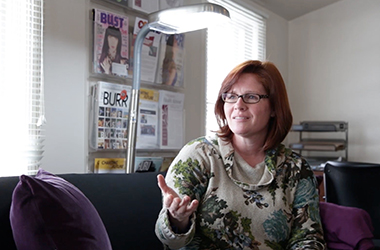Seasonal Affective Disorder leaves people feeling depressed during winter

Cassie Pegg-Kirby, the assistant director of the Women’s Center, discusses the use of the lamp behind her to treat seasonal affectedness disorder. Pegg-Kirby said that the lamp can help treat those affected, but shouldn’t be seen as a cure to it.
February 23, 2014
Cold temperatures, bad roads and lack of sunlight can leave people feeling depressed during the winter months, but these feelings may not be just the typical winter blues — they could be a result of a syndrome called Seasonal Affective Disorder or SAD.
The Women’s Center, located in the Carriage House on Midway Drive, now has a lamp that imitates sunlight to help relieve the symptoms of SAD.
Angela DeJulius, director of University Health Services, described Seasonal Affective Disorder as a mood disorder that affects people most in the winter months. She said it is very closely related to depression, but is usually brushed off as a normal feeling.
“Seasonal Affective Disorder often may be under-diagnosed,” DeJulius said. “One of the issues is that people don’t realize [SAD] is actually what they are experiencing.”
Seasonal Affective Disorder (SAD) from KentWired.com on Vimeo. Video by Brian Smith.
Trevor Russ, a sophomore exploratory major, said he often finds himself in a worse mood than usual when the weather is bad.
“The winter weather makes me borderline angry,” Russ said. “Being cold is uncomfortable, and the absence of sunlight makes me sad.”
DeJulius said SAD symptoms include feelings of sadness, changes in sleep, changes in appetite and changes in energy levels. She said although there are multiple treatments, the symptoms typically improve as the weather gets better.
“SAD does respond to many of the same treatments as other types of depression, so occasionally medicine helps,” DeJulius said. “Counseling can help, exercise can help and getting out in any natural sunlight can help, if there is any.”
Cassandra Pegg-Kirby, assistant director of the Women’s Center, said the lamp is not meant to replace medication or therapy, but rather supplement it.
“It’s meant to boost your serotonin levels and things like that,” Pegg-Kirby said. “It’s basically mimicking what you feel like when you go outside in the sunlight.”
Pegg-Kirby said the Women’s Center has limited space, but she encourages students to schedule a time to come sit under the lamp if they have some time to read or even just catch their breath.
“Our space is limited,” Pegg-Kirby said. “But certainly, if someone wanted to utilize it, we would work to find a time that would fit their schedule and give them the space to themselves.”
Another option to try combat SAD is exercise. One Love Yoga and boutique in downtown Kent held its monthly workshop called Glow with the Flow last Saturday.
“We shut the blinds and light the room with only black lights,” One Love Yoga and boutique owner Tim Huth said. “The students use glow-in-the-dark body paint and glow sticks.”
These yoga classes are just one of many ways to treat SAD.
Pegg-Kirby said that although SAD normally isn’t as severe as depression, it is still something that shouldn’t be overlooked.
“If it starts affecting your daily life and your ability to function, then you really need to check into that and make sure that it’s not something more serious,” she said.
Pegg-Kirby said that symptoms of depression are most intense in the last part of winter, after the excitement of the new snow and the holidays has worn off.
“Come January and February, people are ready for this winter to be over,” she also said. “I think you start feeling that cold in your bones a little bit more than you do in early winter.”
Pegg-Kirby added that with SAD, symptoms tend to fade when the weather gets better.
“In March, we are starting to see the sun a little bit more and the days are starting to get a little bit longer,” said. “So I think we kind of ease out of it.”
To make an appointment to use the SAD lamp, stop by the Women’s Center or call 330-672-9230.
Contact Hannah Reed at [email protected].
























